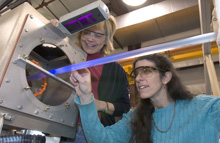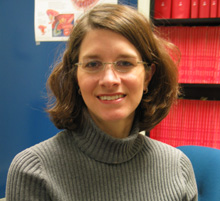 |
Wednesday, February 22, 2006 |
|
Wednesday, February 22
Thursday, February 23 |
|
Extended Forecast |
Secon Level 3 |
|
Wednesday, February 22 - Portabello Harvest Grain - Santa Fe Chicken Quesadilla - Garlic Herb Roasted Pork - Beef Stroganoff - Triple Decker Club - Meatlover's Pizza - Pesto Shrimp Linguine w/Leeks & Tomatoes The Wilson Hall Cafe accepts Visa, Master Card, Discover and American Express. |
|
Wednesday, February 22
Thursday, February 23
Chez Leon Menu |
| Fermilab Today is online at: http://www.fnal.gov/today/ Send comments and suggestions to today@fnal.gov Fermilab Today archive Hurricane Relief Page Fermilab Today PDF Version Fermilab Result of the Week archive Fermilab Safety Tip of the Week archive Linear Collider News archive Fermilab Today classifieds Subscribe/Unsubscribe to |
| MINERνA Recycling Effort Taps Many Lab Resources |
| This is the second article in a series on the MINERνA neutrino experiment. |
|
Recycling is a key part of the prototyping for MINERvA, the point-blank, high-intensity neutrino experiment that will operate in the NuMI Near Hall. For example, the "veto wall," which identifies neutrino events by determining whether they came from the front of the detector, comes from the old NuTeV experiment. "We're borrowing a lot of technology from a lot of different places," says project manager Debbie Harris of PPD's Neutrino Department.
There are many resources open to borrowing at Fermilab, with significant overlap from university contributions. The veto wall is being refurbished at the University of Rochester, and then will be returned to Fermilab for MINERvA. The huge steel rails used to hold components of the MINOS near detector while they were being constructed at New Muon Lab will be used to hold the frames of the MINERvA detectors. The photomultiplier tubes are the same design as those used in MINOS, so all that's required is purchasing more of them. The "trip chips," which digitize the signals coming from the photomultiplier tubes, will be the same as those used at DZero.
At the heart of MINERvA are the scintillator bars, the "active medium" forming the primary target for the scattering of neutrinos. The triangle-shaped scintillator bars are being made at the 70-foot extruder for scintillating plastic at Lab 5, operated jointly by Fermilab and the Northern Illinois Center for Accelerator and Detector Development. Jim Kilmer of PPD's Mechanical Department is determining the best kinds of steel for "partly instrumented" components holding scintillator inside, and for a leakproof exterior. Bob Bradford of the University of Rochester is figuring out how to bring steel and scintillator components together. "All the work is connected and sometimes it's hard to make distinctions," says Harris. "There is very extensive university participation in MINERvA."
|
|
University of Liverpool Press Release,
February 21, 2006:
Physicists step closer to understanding origin of the universe The world's largest particle detector is nearing completion following the construction of its 'endcap' at the University of Liverpool Its assembly of advanced apparatus, at the University's Semiconductor Detector Centre, has been a joint effort by physicists, engineers and technicians from the Universities of Liverpool, Glasgow, Lancaster, Manchester and Sheffield as well as Daresbury and Rutherford Laboratories.
The endcap is part of a semiconductor tracker (SCT) based at the heart of ATLAS - a giant particle detector the size of a five-storey building. The SCT will become part of the world's largest particle accelerator – the Large Hadron Collider (LHC), based at CERN, the European Centre for Particle Physics Research, in Switzerland.
The LHC is being constructed 100 metres underground in a 16-mile long circular tunnel, running under the Franco-Swiss border. Inside the tunnel two particle beams will be accelerated to extremely high energies, and will crash into each other forty million times a second, creating a snapshot of conditions that existed billionths of a second after the 'Big Bang'. ATLAS, the culmination of 15 years' work by over 150 European institutions, aims to find the Higgs particle that holds the key to understanding the origin of mass.
|
|
Submit URA Thesis Award Nominations before March 1 Nominations for the 2006 award must be submitted to Steve Wolbers by March 1, 2006, and should include a letter supporting the merits of the thesis being nominated. To qualify, the thesis must have been submitted as partial fulfillment of the Ph.D. requirements during 2005; it must be written in English, and submitted in electronic form to the Fermilab Publications Office in accordance with Fermilab policy.
Printer Down
PC Manager Meeting Today
International Folk Dancing
Unix Users Meeting
English country dancing
|

